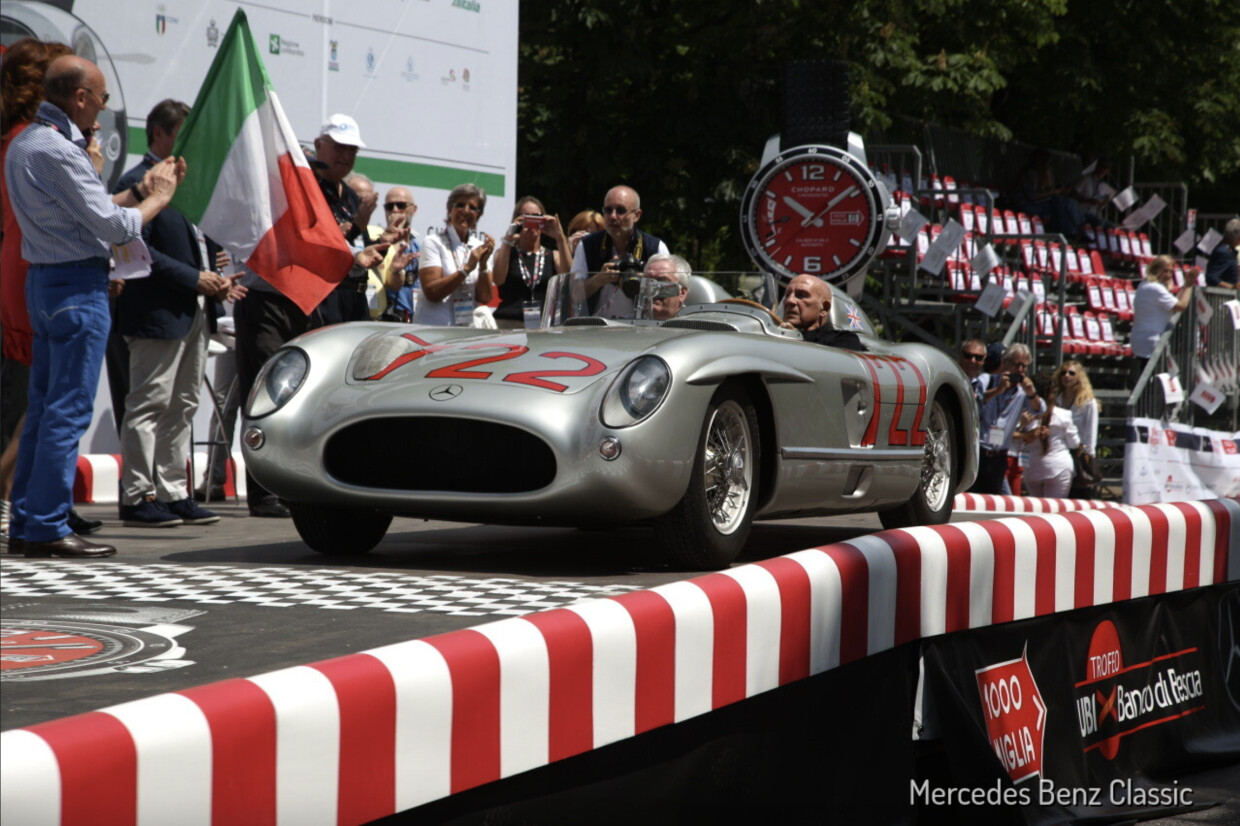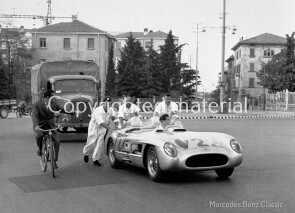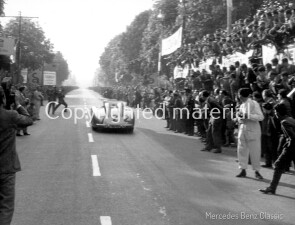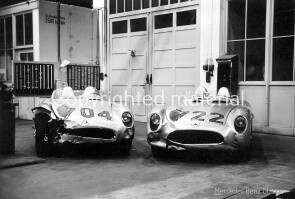
1955 Mercedes-Benz 300 SLR
ON/OFF
Why am I an Automotive Masterpiece?
H. Works cars
Daimler-Benz AG (D)
L. Limited edition cars
no. 10 manufactured, 4th built. No. 10 manufactured, 4th built
At the start of the 1950s Mercedes-Benz decided to re-enter the racing world, and asked chief engineer Rudolph Uhlenhaut to create something special. “Rudy” came up with project R (as in “Rennwagen”, the German word for racing car) 196, a single car capable of competing and winning a Formula 1 grand prix – in single seater configuration with both open and closed wheels and an 8 cylinder 2.5 liter engine – as well as road races in the R196S configuration with two seats, covered wheels and a 3 liter engine. Nine of this latter “Sports” version were built. Of these chassis no. 03, 04, 05 and 06 were entered in the 1955 Mille Miglia, the model’s debut race. Chassis no. 01 and 02 were never used in races, but used as test and practices cars. Chassis no. 07 and 08 were the Coupé Uhlenhaut type, 09 was never assembled and 10 was the “prototype” prepared as a development model for the 1956 season.
Before the Mille Miglia scheduled for 1 May 1955, the cars that were to take part were being completed in rapid succession. On 20 April, the same day that saw the completion of the chassis for 300 SLR 196.110-00003/55, chassis 196.110-00004/55 was also fully assembled, with a weight of 63 kg. As had become usual, the bodywork of Elektron panels was mounted on the frame on the same day. This was a two-seater version with the windscreen extending across the entire vehicle width. Engine M 196/60 was installed as the power unit. The documentation records that it was also on 20 April that the first dynamometer test was carried out-indicating the extremely tight time schedule before the Mille Miglia. On 26 April Moss carried out a test drive with chassis no. 00004 in Hockenheim. At the special request of Moss, a three-spoke steering wheel and a shorter steering column were installed. Moss and his co-driver Denis Jenkinson drove to victory in the Mille Miglia in a new record time. Despite replacement of the rear tyres in Rome, their average speed of 97,96 mph was never to be beaten. At the finishing line in Brescia the odometer showed a total mileage of 1953 km. After a motorway test drive which showed no problems with the engine whatsoever, engine M 196/60 used in the race was nonetheless removed in accordance with the maintenance routine, having covered 1988 km. On 21 May engine M 196/58 was installed to replace it. On the same day the frame was inspected for cracks, the body damage incurred during the Mille Miglia was repaired and a one-seater windscreen was installed. After installation of a longer steering column, the car was tested on the dynamometer. The next assignment for 300 SLR/00004 was the International ADAC Eifel Race to be held from 26 to 29 May at Nürburgring. Driven by Karl Kling with an average speed of 77,17 mph, the car unfortunately only achieved fourth place: on the final lap a »control fault« occurred which lost him his third place just before the finishing line. After this race the odometer reading was recorded as 2400 km. On 1 June the defective engine M 196/58 used in the race was removed, and on 3 June the new engine M 196/65 was installed in its place. At the same time the frame was inspected for cracks, and an air brake including the operating hydraulics installed. After the practice runs on the Circuit de la Sarthe, this engine was removed on 9 June. Engine M 196/68 was installed on the next day, and remained in the car until the withdrawal of the entire Mercedes-Benz team in the early morning of 12 June. At that time the driver duo of Karl Kling and Andre Simon lay in third place in the overall rating. Following the catastrophic outcome of the race in Le Mans, engine M 196/68 used in the race was removed in the Untertürkheim racing department on 15 June for a routine overhaul. On 27 July it was replaced with engine M 196/63. As usual the frame was inspected for cracks on the same day. The opportunity was also taken to replace the upper transverse strut of Avional with a steel strut. The bodywork was also inspected for hidden damage, and at the request of Moss a shorter steering column and a three-spoke steering wheel were installed again. On 29 July the car underwent a final test on the dynamometer. The next assignment for the car was the Swedish Grand Prix scheduled for 7 August in Kristianstad. This time 300 SLR chassis no. 00004 was driven by Stirling Moss. After the first practice run, and as in the case of Fangio's car, the brakes were replaced and gears 4 and 5 were given a lower ratio, so that in 4th gear the car no longer achieved 120 mph, but only 116 mph, and in 5th gear only 140 mph rather than 155 mph. During the second practice run scheduled for Saturday, Moss had no complaints to make about his car. Moss finished the race covering 32 laps of 6.5 km in second place, just behind the winner Fangio. He achieved an average speed of 101,20 mph. Following the car's return from Sweden, engine M 196/63 used in the race was removed on 11 August. On 6 September it was replaced with engine M 196/68 for the next assignment, the RAC Tourist Trophy in Dundrod, Northern lreland. The body and frame of the car had already been closely scrutinised for damage three days previously. The air brake and hydraulic operating mechanism used in Le Mans and Sweden were removed. The final acceptance test for the overhauled 300 SLR took place on 8 September, on the dynamometer. A total mileage of 4937 km was recorded for the car at that time. Stirling Moss and John Fitch were chosen as the drivers for the race on the fast road circuit in Northern lreland. After the first practice run on 15 September, a higher ratio (0.8621) was installed for 5th gear. The engine was reaching excessive speeds in top gear with the original ratio. Once these adjustments had been made, the car performed flawlessly on the second day of practice. With an average speed of 88,46 mph, the Moss/Fitch duo driving chassis no. 00004 emerged victorious ahead of their team colleagues Fangio/Kling and von Trips/Simon. At the finishing line the car had an odometer reading of 6165 km. After its use in the Tourist Trophy, the car was subjected to the usual maintenance routine: On 23 September engine M 196/68 was removed and replaced with engine M 194/64 on 3 October. The chassis frame was also inspected for cracks. The aluminium struts for the transmission and at the front for the oil reservoir were replaced with steel struts. The preparations for the Targa Florio were completed on 5 October, with a test run on the dynamometer. In Sicily Moss and his new team colleague Peter Collins covered 190 practice kilometres in the car between 7 and 15 October. Moss continued his run of successes with 300 SLR chassis no. 00004. Together with Collins he crossed the finishing line as the winner after 09:46:14 hours and 936 race kilometres. The British driver duo achieved an average speed of 59,83 mph. At the end of its racing career, during which it achieved outstanding victories, the car had covered a total mileage of 7291 km. That was the reading when the car was retired at the end of 1955. 300 SLR chassis no. 00004 was briefly reactivated on 6 March 1957, when it was made ready for a journey by Daimler-Benz Board of Management member Dr Hans Moll. To this end direction indicators with an operating switch and an enormous Eberspächer silencer on the right-hand flank were installed. On 22 and 23 March, Moll covered a total of 250 km with the car. The number on the red test registration plate was S-042. To this day the 300 SLR chassis no. 00004 has remained on the Museum inventory of Daimler AG, in the care of Mercedes-Benz Classic.







